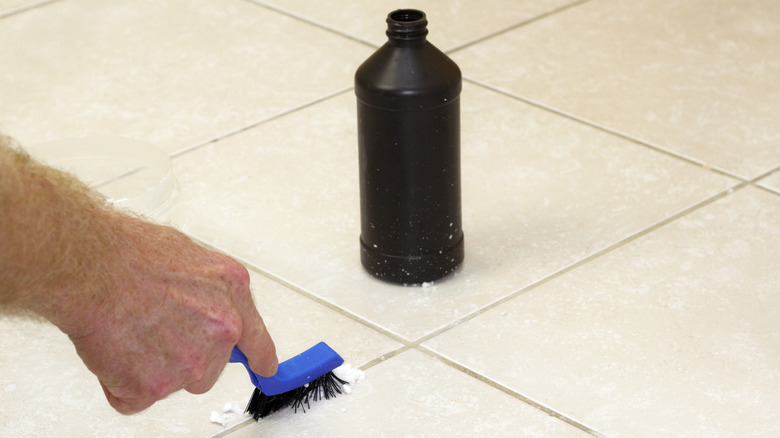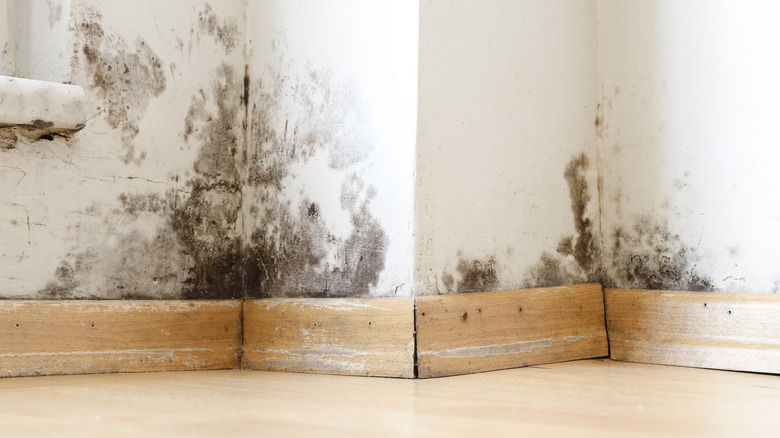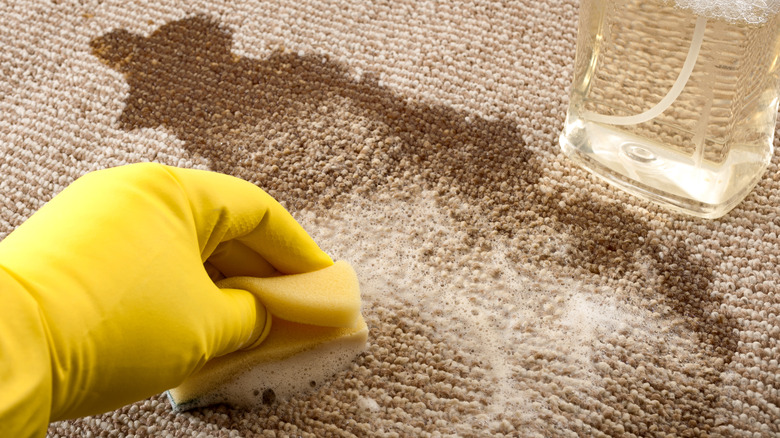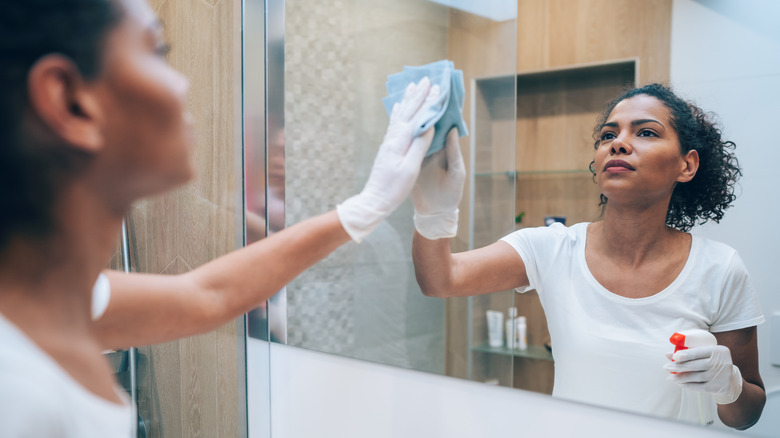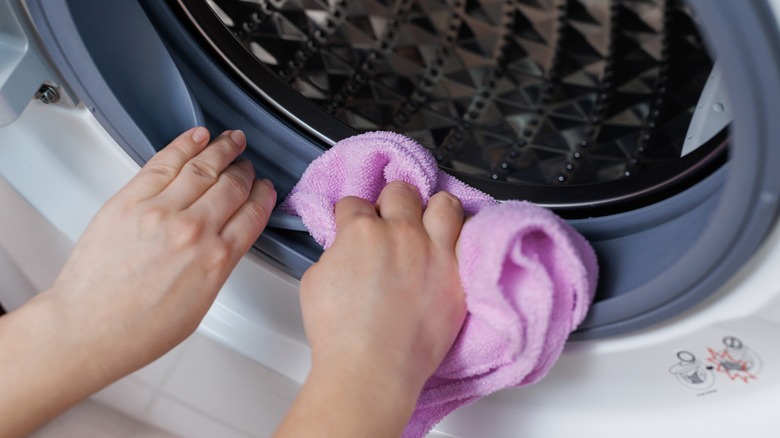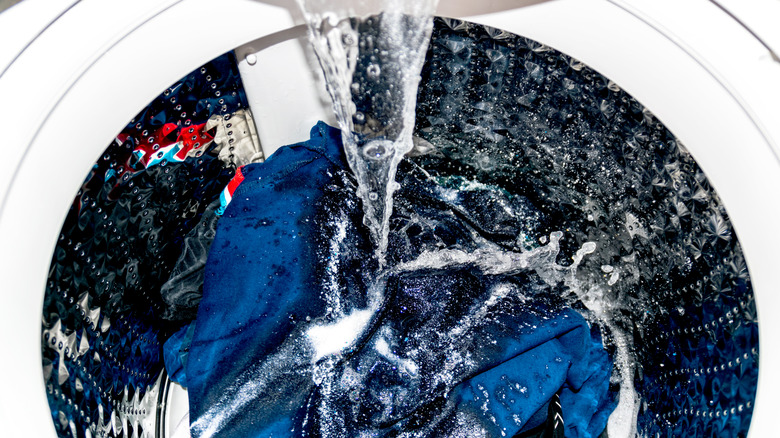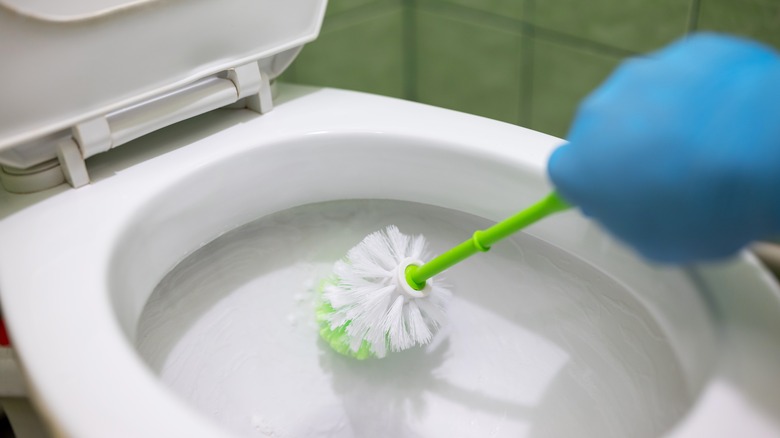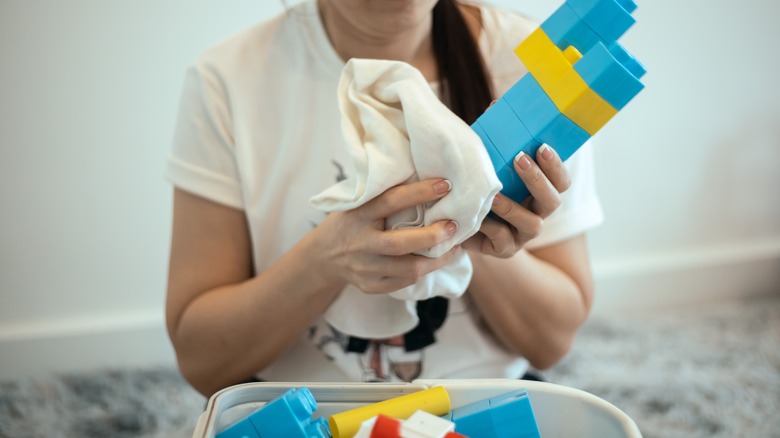8 Ways To Use Hydrogen Peroxide Around Your Basement
We may receive a commission on purchases made from links.
Whether you have a finished basement or you solely use the space to store boxes and other items, it always seems like there is something that needs cleaning and your attention. Whether it is as simple as a grimy bathroom or streaky window, or something more concerning like a patch of mold on the wall, maintaining your basement can be a challenge. Fortunately, there is one product that you may have stashed with your other cleaning supplies or even in the medicine cabinet that can help: hydrogen peroxide.
Hydrogen peroxide (H2O2) is an antiseptic, and, due to that second oxygen molecule that sets this liquid apart from simple water, it is a very versatile cleaner and disinfectant. As Dr. Sarah Pickering Beers told Cleveland Clinic, "The extra oxygen molecule oxidizes, which is how peroxide gets its power. This oxidation kills germs and bleaches color from porous surfaces like fabrics." The more you learn about what it can do, the more ways you'll discover to use it in your basement. Plus, unlike many other chemical cleaners that are considered toxic, the EWG ranks hydrogen peroxide as low-risk for all of its indicators (which include asthma and respiratory problems, skin allergies and irritation, cancer, the environment, and development and reproductive toxicity). Discover some of the best ways to make use of this powerful cleaner in your basement in the sections that follow.
Kill mold and mildew lurking in the basement
Mold growing in your basement can pose a serious health threat. Those with allergies or asthma are likely to have a reaction to the spores. It can also make it so household members become less resistant to other illnesses. Long-term exposure can potentially cause cognitive issues, respiratory problems, and more. Fortunately, you can use hydrogen peroxide to get rid of mold on a variety of surfaces in the basement (though it might not be as effective on porous surfaces, such as carpets and MDF). While wearing gloves and a mask, begin by spraying any moldy areas with hydrogen peroxide (at least a 3% concentration, like the McKesson Hydrogen Peroxide Topical Solution). Allow the cleaner to sit for about 10 minutes, and then scrub it until all of the mold is removed. Repeat the steps as necessary. Use a damp rag to wipe everything down to ensure no mold spores remain on the affected item or surface.
After applying the hydrogen peroxide to moldy surfaces, you should notice that it starts bubbling. This bubbling signals that the oxidizing reaction is occurring. Hydrogen peroxide can produce hydroxyl free radicals in the presence of organic matter. These free radicals attach to mold, bacteria, and other microorganisms, breaking down their cellular components.
While hydrogen peroxide is safer than bleach, it may not be as effective, particularly on established mold growth or very heavy mold stains. That said, a 2013 study in the Journal of Occupational and Environmental Hygiene found that neither bleach nor hydrogen peroxide stopped mold growth long-term, especially in porous materials like wood. In summary, hydrogen peroxide is best for light mold stains on hard surfaces, you might want to try bleach for darker mold marks, and professional removal may be needed for more serious mold problems.
Remove stains from carpets or concrete basement floors
Stains happen on basement floors. Thankfully, a little hydrogen peroxide may help you take care of these marks. If you have concrete floors, start by pouring a small amount of water over the stain, then follow it up with some hydrogen peroxide, giving it at least 20 minutes to sit, so the hydroxyl free radicals can work to break down the double bonds in the stain and the mark can be oxidized. Use a damp scrub brush to agitate the stain and help lift it from the concrete. Hydrogen peroxide can help remove a variety of stains from concrete, including those caused by oil and dirt.
Additionally, hydrogen peroxide can lift carpet stains caused by rust and other substances, thanks to it being a slightly acidic oxidizing agent that breaks down iron oxide (aka rust). To be safe, only use it on light-colored synthetic carpets. If you have darker-colored carpets, you'll be running the risk of bleaching the color if the peroxide remains on the stained area for too long, or if you used a higher concentration than what is recommended.
When cleaning lighter-colored carpets with hydrogen peroxide, stick with a concentration that is no higher than 3%. This will minimize the risk of any bleaching. Combine the hydrogen peroxide with water in a spray bottle (1:1 ratio) and test it on an inconspicuous section of the carpet before tackling the stain. After confirming that it did not alter the color, use the solution to spray the stained area. Use a soft-bristled brush, such as the WDDBHSKN Cleaning Scrub Brush, to agitate the stain before letting the solution sit for five minutes. Rinse the area and blot up all the excess cleaning solution.
Whiten grout in basement bathrooms
Keeping grout clean on basement floors or in showers can feel like a never-ending battle. Thankfully, with the addition of some hydrogen peroxide, your cleaning arsenal can get a major upgrade. Hydrogen peroxide is a bleaching agent, rendering it a useful aid to get those grout lines looking bright and clean once more. Bleaching agents like hydrogen peroxide fade stains by dissembling the part of their chemical structure that is responsible for coloration (scientifically known as chromophores). If your grout has developed mold, the hydroxyl free radicals in hydrogen peroxide will do you the extra service of breaking down the mold cells responsible for those unsightly dark marks.
To boost the cleaning power of hydrogen peroxide, try using it with some baking soda on your grout. Some sources state that this combination creates oxygenated bleach (sodium carbonate peroxyhydrate). Combining baking soda and hydrogen peroxide is unlikely to create at-home oxygen bleach (you need precise parameters for this reaction to occur), but it can accelerate the fizzing of the hydrogen peroxide and give your mix some abrasive power. If you want to try this technique, mix the two substances together to make a thick paste (add about one part hydrogen peroxide to two parts baking soda). You can spread the paste over the grout, let it sit for 10 to 15 minutes, and then lightly scrub before rinsing the surface clean.
Clean windows and other glass items in the basement
Basement windows, mirrors, and other glass items can also be cleaned with hydrogen peroxide, which will assist to eliminate dirt and buildup due to its oxidizing power. As the hydroxyl free radicals produced by hydrogen peroxide react with filmy grime on the surface of your windows or mirrors, they'll help break through it. Depending on the level of grime covering the surface, you might want to give the solution up to 15 minutes to sit. Once the reaction is complete, you should be easily able to wipe the surface, leaving it clean and streak-free.
Cleaning your windows with hydrogen peroxide is simple. In addition to the hydrogen peroxide, you'll only need some water and a little bit of dish soap. Combine the water and hydrogen peroxide in a spray bottle (in a 5:1 ratio), and then add just one drop of dish soap. Spray windows and mirrors, and then wipe them clean using a microfiber cloth (it won't tear or shed lint, unlike paper towels or other rags). To ensure no streaks are left behind, wipe using circular motions.
Use hydrogen peroxide to clean washing machines in the basement
Your washing machine works to keep your clothing and linens fresh. However, it too needs regular cleaning to prevent mold or mildew from growing. If your washer is in the basement, frequent cleaning is even more important to help combat the higher humidity levels that can encourage spores to take hold. Luckily, hydrogen peroxide offers an affordable and effective solution to help you keep your appliance clean — and we have its disinfectant properties to thank for that. By cleaning your washing machine with hydrogen peroxide, you can combat mold, bacteria, yeast, and more, via its oxidative action and the hydroxyl free radicals it produces. As these free radicals come into contact with microorganisms lurking in your washer, they'll work to destroy the DNA and cellular makeup, helping to lift the microorganisms from the interior of the drum and pipes and allowing them to get washed away during the cycle.
Adding about 2 cups of hydrogen peroxide to a dry and empty washing machine, and then selecting the self-cleaning cycle (or the longest and hottest cycle that is available) can remove buildup and other gunk from the inside of the tub. After the wash cycle finishes, use a microfiber towel, such as the AIDEA Microfiber Cleaning Cloth, to wipe down the interior and remove any remaining residue. You can use hydrogen peroxide to clean washing machines with tubs made of various materials, including stainless steel, enamel, or plastic. Then, pour some onto a clean cloth, and use it to wipe down the rubber gasket around the opening. If ignored for long periods of time, it can begin to grow mildew and fungi. Additionally, adding hydrogen peroxide to empty detergent dispensers before starting the cycle can help remove any buildup from them, too.
Freshen laundry and remove stains from clothes
In addition to ridding the washing machine of build-up, you can also use hydrogen peroxide to clean your laundry. This is because of its bleaching properties and ability to oxidize stains from substances like coffee, tea, red wine, and fruit juice. The science behind how hydrogen peroxide works to target stains and make whites brighter once again ties back to its interaction with the color-forming component in the stains' chemical structure. By breaking down the double bonds, hydrogen peroxide can help to both lift and lighten the appearance of stains by rendering them colorless. Compared to bleach (also an oxidizing substance) and some other laundry additives, hydrogen peroxide is a more environmentally friendly option. It breaks down into water and oxygen, meaning no toxic chemicals are released into the air or water.
If you're wondering how it compares to bleach, here's what you need to know. While hydrogen peroxide can lift stains and offers lightening properties, bleach is a more potent whitening and disinfecting agent. Bleach's chemical formula is NaClO (sodium, chlorine, and oxygen), while hydrogen peroxide's is H2O2 (hydrogen and oxygen). Chlorine is better able to gain electrons when interacting with other substances than oxygen. This means that it has a higher reduction potential and will be more effective at oxidizing and removing stains and bacteria.
However, a study published in 2021 in the journal Molecules revealed that 3% hydrogen peroxide reduced bacteria growth in laundry loads by 99.9999%, and that it did a good job of cleaning soiled items and lightening stains from substances like blood, milk, ink, and red wine, without damaging fabrics. So while you probably can't render an old, badly yellowed towel pure white once more without traditional bleach — if you go in with realistic expectations, hydrogen peroxide can be an effective and environmentally friendly laundry solution that shouldn't weaken fabrics.
Clean basement toilets
Keeping the toilet in your basement — and on other floors of your home — clean is important. Beyond the obvious aesthetics, clean toilets are less likely to spread bacteria or germs, keeping everyone in the house healthier. Hydrogen peroxide can help with this task as well. As mentioned earlier, it has been shown to be effective at killing fungi, viruses, mold spores, yeast, and bacteria, because of the destructive properties of the hydroxyl free radicals that break down cellular structures and DNA of a variety of microorganisms.
Cleaning your toilet with hydrogen peroxide is pretty straightforward. Pour ½ to 1 cup of the product into the toilet bowl and leave it to sit and work its magic for about half an hour. Then, use a toilet brush to scrub the inside of the bowl. The oxidizing action of the hydrogen peroxide will help break down stains, helping you to scrub them off with the brush. If your toilet has hard water stains, you can also experiment with using hydrogen peroxide on them. For this, you'll want to make a thick paste by mixing a little hydrogen peroxide with baking soda, the latter of which adds an abrasive element to the cleaning solution. Baking soda is also basic, so when combined with the slightly acidic hydrogen peroxide, it creates a fizzing effect that may aid in lifting the stains. Apply the paste directly onto the hard water stains. Let it sit for about half an hour before scrubbing and rinsing the area. But be warned, hard water stains are notoriously tough to lift. If you find that the hydrogen peroxide hasn't done much, then you may need to try out some of these alternative ways to get rid of hard water stains in your toilet.
Refresh basement playroom toys
Keeping the toys in a basement playroom clean can help prevent the spread of germs and diseases. However, you don't want to use toxic chemicals that would present a new health threat for your children, especially if they're young and prone to putting things in their mouths. The non-toxic, yet effective, disinfecting properties of hydrogen peroxide makes it an ideal pick for this task.
Begin by wiping the toys down with a microfiber cloth to remove any loose dirt or dust. Then, you'll be ready to use the hydrogen peroxide to disinfect the surface. Add hydrogen peroxide and water to a spray bottle (in a 1:1 ratio) and use it to spray down the toys. Let the solution sit on the toys for at least five minutes before drying them. Alternatively, you can just let the toys air dry fully before letting children play with them. As the solution sits on the surface, a chemical reaction should occur where those hydroxyl free radicals attack the structural components of any viruses, bacteria, or other yucky microorganisms that are hiding on your children's toys.
